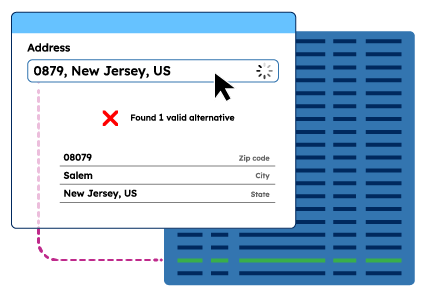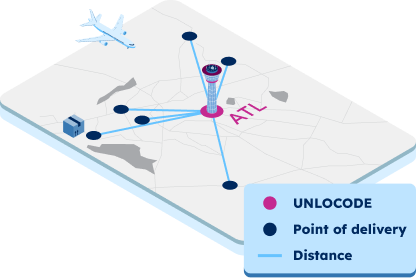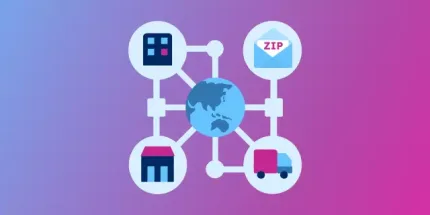


Enterprise Address Validation

CO2 calculation

Map Visualization

UNLOCODE and IATA codes


"I think we work really well together and have developed an excellent solution. We spent years trying to implement this with other providers without much success. Eventually, MercuryGate acknowledged that they were hemorrhaging money and needed to act. Pedro was fantastic to collaborate with in creating a customized solution."
Mike Brady
Product Manager

"GeoPostcodes' data offers two big advantages for us: we save a lot of time, and we can validate wether the postal code we have exists."
William Chao
Product Owner, Geographic Information Services
Optimized ocean freight operations

Zone-based tariff calculation

Customs compliance

Network design & optimization

Why choose GeoPostcodes
Global coverage
Complete coverage across 247 countries, including hard-to-source geographies like China, Japan, Brazil, and Russia.
Highest quality
Built on extensive, authoritative sourcing with robust data engineering and quality control. Standardized and up-to-date.
Expert Consulting
With 15 years of experience, we guide your implementation and deliver data in the format that fits your system.
Our selection for Supply Chain and
Master Data Management
Frequently Asked Questions
Master Data Management (MDM) in the supply chain context refers to the processes used to manage and maintain reliable data related to products, suppliers, customers, and other key entities within the supply chain. The goal for supply chain professionals is to ensure that accurate and consistent data are available and used across the entire supply chain network.
Key components of Master Data Management in the Supply Chain process include Location Data, Product Data, Supplier Data or Customer Data. Learn how to build your MDM strategy here.
Yes, Master Data is an integral part of Supply Chain Management (SCM). Master Data includes critical information about products, suppliers, customers, locations, and other core elements of the supply chain. This data is the foundation upon which supply chain processes and decisions are built.
Therefore, data quality is key for a successful MDM strategy.
In SAP, Master Data objects are used to define and manage the core data elements that are essential for the planning and execution of supply chain processes.
Master data objects can vary depending on the version of SAP and individual configurations. The most common ones include Product Master Data, Location Master Data, Supplier Master Data, Customer Master Data, Material Master Data, and Transportation Routes Master Data.
Master Data Management (MDM) is a set of processes, governance, policies, standards, and tools to create and manage critical data shared across an organization. The primary goal of MDM is to ensure that essential data is accurate, consistent, and available for decision-making and operational processes.
Location Master Data provides the foundation for efficient and effective Supply Chain Management. With accurate and up-to-date location data, organizations can handle inventory management, transportation optimization, order fulfillment, and overall supply chain performance.
Therefore, maintaining high-quality location data is crucial for organizations looking to streamline their supply chain operations, reduce costs, and meet customer demands effectively.
What is location analysis in logistics? Location analysis in logistics evaluates accurate location data to strategically position distribution centers and optimize routes for maximum operational efficiency. It leverages sophisticated location intelligence and comprehensive spatial data to thoroughly analyze proximity to suppliers and customers, transportation accessibility, infrastructure quality, and various cost factors across potential sites. This systematic analytical process enhances end-to-end supply chain visibility, allowing companies to identify bottlenecks and inefficiencies before they impact performance. The resulting improvements lead to heightened customer satisfaction through faster delivery times and reduced errors, while simultaneously boosting operational efficiency through reduced transportation costs and optimized resource allocation. By incorporating real-time location-based data analysis, companies can make dynamic adjustments to their logistics networks in response to changing market conditions, weather disruptions, or unexpected demand fluctuations, creating resilient and adaptive supply chains that maintain competitive advantage.
Logistics requires accurate location data, real-time tracking information, and spatial data for distribution centers and routes. Essential elements include location-based data on transit times, real-time data on inventory positions, customer locations for delivery routes, and predictive analytics to anticipate supply chain visibility challenges.
Location data for logistics includes precise coordinates, postal codes, and spatial data that powers location intelligence. It encompasses real-time location data for tracking, geographic information for distribution centers, and contextual data to optimize delivery routes. This information supports predictive analytics and enhances supply chain visibility.
The 5 P’s include Planning (using location intelligence for network design), Performance (measuring real-time data metrics), Processes (optimizing routes through location data for logistics), People (enhancing customer satisfaction), and Partnerships (improving supply chain visibility through shared accurate location data and predictive analytics).
Using accurate location data is essential for optimizing location data for logistics. It enables precise route planning, reduces delivery times, and minimizes failed deliveries, directly enhancing customer satisfaction. By leveraging location intelligence, logistics companies can track shipments in real time, identify bottlenecks, and improve overall efficiency.
For example, location intelligence helps ensure drivers take the most efficient routes, reducing delays and operational costs. Additionally, real-time updates allow businesses to proactively communicate with customers, improving trust and satisfaction. Integrating accurate location data into logistics systems leads to a smoother, more reliable supply chain.





